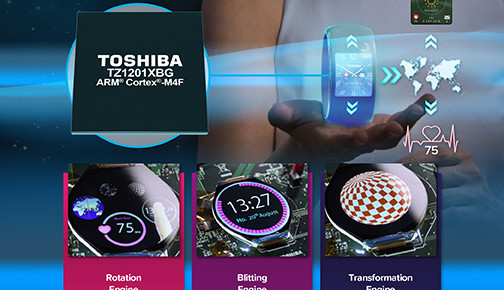Low-power graphics processor for wearables
July 31, 2017
on
on

Although taste is subjective most people like slick graphics, which is why smartphones and smart watches come with full color, high-resolution displays, and why graphics designers can make a living from icon design for mobile device applications. The problem with nice graphics, however, is that they require a lot of computing power and energy, and place a heavy load on the usual small batteries of portable gadgets.
The new TZ1201XBG microcontroller from Toshiba is not only low-power, the device also integrates a graphics controller with 2D graphics accelerator. Based on a 32-bit ARM Cortex-M4F clocked at 96 MHz, the device consumes as little as 70uA per MHz when running in active mode, meaning that a watch with a 350 mAh battery could keep its display on for one month on a single charge when showing time with seconds resolution.
Besides a graphics engine the chip is also equipped with an LCD interface (supporting 480 x 320 HVGA at 30 fps or 320 x 240 QVGA at 60 fps), 2.2 MB SRAM, and a 22-bit (effective) high-precision analog front end capable of measuring weak signals such as EEG or EMG, as well as impedance, that can be used to determine the stress level index by calculating skin resistance.
The new TZ1201XBG microcontroller from Toshiba is not only low-power, the device also integrates a graphics controller with 2D graphics accelerator. Based on a 32-bit ARM Cortex-M4F clocked at 96 MHz, the device consumes as little as 70uA per MHz when running in active mode, meaning that a watch with a 350 mAh battery could keep its display on for one month on a single charge when showing time with seconds resolution.
Besides a graphics engine the chip is also equipped with an LCD interface (supporting 480 x 320 HVGA at 30 fps or 320 x 240 QVGA at 60 fps), 2.2 MB SRAM, and a 22-bit (effective) high-precision analog front end capable of measuring weak signals such as EEG or EMG, as well as impedance, that can be used to determine the stress level index by calculating skin resistance.
Read full article
Hide full article


Discussion (0 comments)